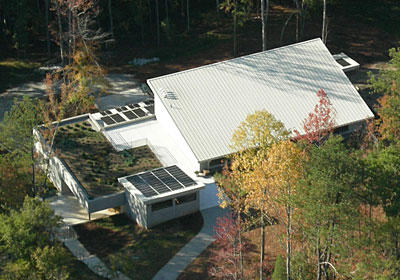
Does your office environment get you down? Then you might want to consider working with Tom Hicks. A vice president at the U.S. Green Building Council (USGBC), which awards ratings to buildings that achieve environmentally friendly targets, Hicks has the fortune to work in a building that has achieved “gold” status, and on a floor that has gone platinum.
In buildings that receive USGBC’s “platinum” certification, its highest rating, natural light permeates the entire floor. Sometimes, cubicles have their own thermostats, so employees can control the temperature. The roof of Hicks’ building, at 1800 Pennsylvania Avenue, has a garden so workers can take a relaxing break at lunch. Oh, and by the way, the urinals don’t flush. But Hicks promises they still smell fresh and clean. “They work wonderfully,” he says. “I know it’s hard to imagine.”
Green building is a growing trend, in part because companies have realized they can actually save money by making a few environmentally friendly upgrades. Adobe Systems (nasdaq: ADBE – news – people ), for example, says it has spent $650,000 since 2001 to upgrade two San Jose buildings, and saved $728,000. The California Environmental Protection Agency spent $500,000 to make its building environmentally friendly, and is saving $610,000 a year. The upgrades also increased the building’s value by $12 million, according to the USGBC. “The return on that investment is really high,” Hicks says.
The USGBC developed its rating system–known as Leadership in Energy and Environmental Design, or LEED–in 2000, and since then 715 buildings have achieved some level of certification. Only 31 have gone platinum. But that number should increase in the years ahead. In 2006, more than $10 billion in commercial construction starts registered their intent to pursue LEED certification, Hicks says. That’s about 5% of the $200 billion commercial real estate industry, according to Hicks.
Adobe is the only major corporation to receive the platinum certification; three of its buildings reached the highest rating last year. To get there, buildings must receive 80% of all the possible points that the USGBC awards. By contrast, buildings need 60% of all available points for a gold rating, 50% for silver and 40% for “certification.”
Energy efficiency and water conservation are both important parts of the rankings. But buildings can also receive points for using native plants in landscaping instead of just laying down sod. And the California EPA building in Sacramento produces virtually no waste. It recycles paper and bottles, and creates compost with leftovers from the cafeteria.
The work environment is also key. Buildings can earn points by creating a clean, bright, healthy workplace for workers–for example, by installing a rooftop garden like the one at 1800 Pennsylvania Avenue. Natural light improves worker well being as much as it boosts energy efficiency. “We spend about 90% of our time indoors,” Hicks says. “These buildings spend a lot of their attention on indoor environ quality. … There are countless studies that show that natural light improves productivity.”
Companies are becoming more attuned to green building practices in part because incentives are starting to change, says Betsy Pettit, an architect and principal with Boston-based Building Science Consulting. Developers are now taking on full-service roles, paying the heat and electric bills for their tenants. That gives them an incentive to incorporate energy-saving technologies. “The reason we’ve always allowed the utility bill to be paid by the tenant or resident is because we feel that will make them conserve more,” Pettit says. “But that really doesn’t give anyone an incentive to provide conservation methods.”
You can see photos here.
